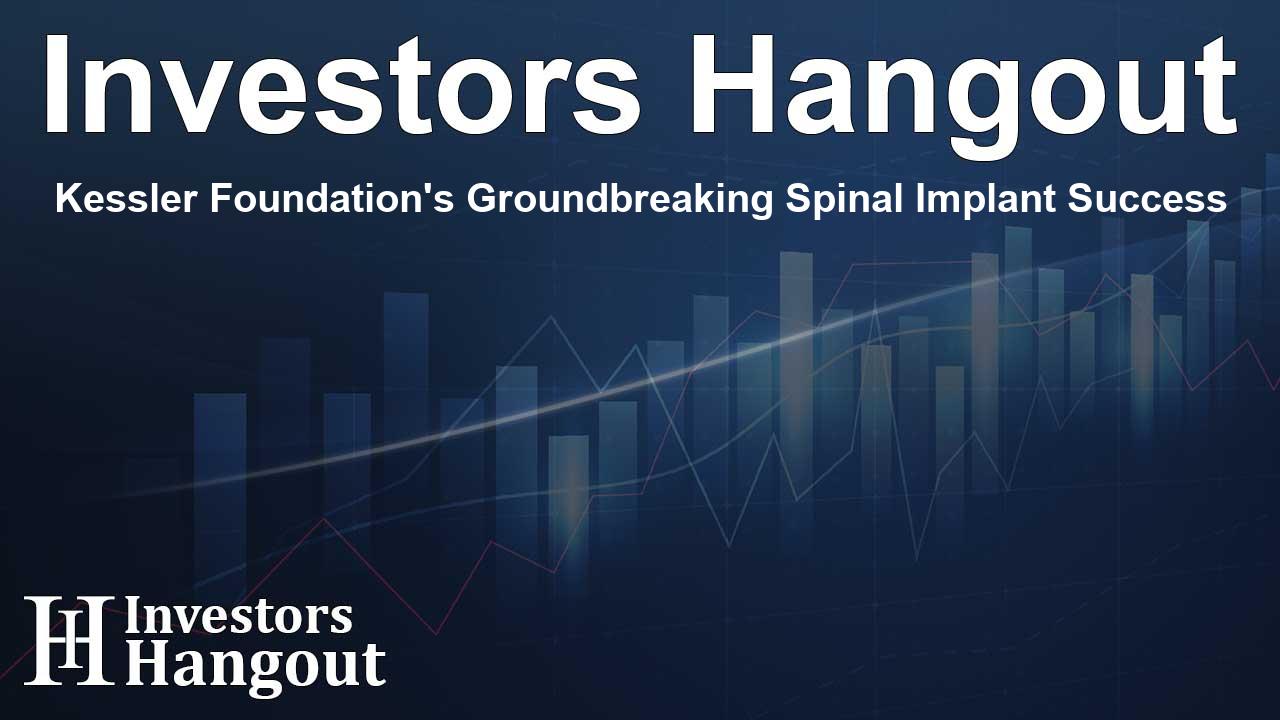Kessler Foundation's Groundbreaking Spinal Implant Success

Kessler Foundation's Innovative Work in Spinal Stimulation
Kessler Foundation, in partnership with Overlook Medical Center, is making strides in spinal cord rehabilitation with the recent implantation of a novel spinal cord epidural stimulator. This pioneering technique uses advanced electrical stimulation combined with comprehensive training programs to help individuals with spinal cord injuries regain mobility and independence, marking a significant milestone in treatment options for those affected by paralysis.
Advancements in Spinal Cord Injury Treatment
The recent surgery, conducted at the state-of-the-art Tim and Caroline Reynolds Center for Spinal Stimulation, represents a breakthrough in addressing spinal cord injuries. The procedure, which was already met with excitement by the research community, involved collaboration with neurosurgeon Robert F. Heary, MD, and was made possible through generous funding from the Joseph and Cheryl Marino Family Foundation.
The Promise of Epidural Stimulation
This groundbreaking technique uses a device that delivers electrical impulses directly to the spinal cord, aiming to restore critical bodily functions. Such advancements are designed to enhance not only motor function but motor skills and overall quality of life. The ongoing research at Kessler Foundation is focused on understanding how this technology can affect bladder control and movement in those who have sustained spinal injuries for less than a year.
Success Stories and Future Plans
Dr. Gail Forrest, director of the Reynolds Center, has highlighted the profound potential of spinal cord stimulation. According to Dr. Forrest, "This success underscores the potential of epidural spinal stimulation to change lives." The program has already made an impact, with more than 70 individuals having participated and contributed to the progress at the center.
Building on Research and Technology
Claudia Angeli, PhD, assistant director at the Reynolds Center, expressed optimism about future possibilities. "We are eager to expand our understanding of the benefits of spinal cord epidural stimulation in our endeavor to make this technology more accessible to all with spinal cord injuries," Dr. Angeli stated. The research team plans to continue these innovative surgical procedures as funding and support permits.
Kessler Foundation's Commitment to Rehabilitation
Kessler Foundation is dedicated to fostering advancements in rehabilitation research. As noted by Steven Kirshblum, MD, the Chief Medical Officer at Kessler Foundation, the successful spinal epidural implant represents a key development in the realm of therapeutic technologies for spinal cord injury treatment. The foundation aims to pioneer further improvements that enhance recovery outcomes across multiple domains, thus paving the path for better future prospects for its patients.
By partnering with Atlantic Health System, Kessler Foundation is on a mission to provide comprehensive research-driven services that expand possibilities for individuals navigating life after a spinal cord injury. With support from generous donors and the Reynolds Foundation, the center continues to transform recovery narratives.
About Kessler Foundation
Kessler Foundation is a highly regarded nonprofit organization at the forefront of rehabilitation research, dedicated to improving the lives of individuals with neurological and developmental disabilities. With advanced initiatives aimed at boosting mobility, cognitive function, and long-term employment outcomes, Kessler Foundation stands as a leader in supporting individuals with conditions such as spinal cord injury and other life-altering challenges.
Frequently Asked Questions
What is the significance of the spinal cord stimulator implant?
The implantation of the spinal cord stimulator represents a major advancement in treatment for individuals suffering from paralysis, restoring motor function and autonomy.
How does the spinal stimulator work?
This device delivers electrical impulses to stimulate the spinal cord, aiding in the restoration of motor functions and improving quality of life for users.
What is the role of the Tim and Caroline Reynolds Center?
The Reynolds Center focuses on innovative spinal cord injury treatments, combining surgical techniques with extensive rehabilitation training.
Who funded the recent spinal implantation procedure?
The procedure was funded by the Joseph and Cheryl Marino Family Foundation, reflecting the commitment to supporting cutting-edge medical research.
What are the future plans for spinal cord stimulation research?
Kessler Foundation intends to continue research in spinal cord stimulation and expand surgical programs to help more individuals with spinal injuries regain functionality.
About The Author
Contact Henry Turner privately here. Or send an email with ATTN: Henry Turner as the subject to contact@investorshangout.com.
About Investors Hangout
Investors Hangout is a leading online stock forum for financial discussion and learning, offering a wide range of free tools and resources. It draws in traders of all levels, who exchange market knowledge, investigate trading tactics, and keep an eye on industry developments in real time. Featuring financial articles, stock message boards, quotes, charts, company profiles, and live news updates. Through cooperative learning and a wealth of informational resources, it helps users from novices creating their first portfolios to experts honing their techniques. Join Investors Hangout today: https://investorshangout.com/
The content of this article is based on factual, publicly available information and does not represent legal, financial, or investment advice. Investors Hangout does not offer financial advice, and the author is not a licensed financial advisor. Consult a qualified advisor before making any financial or investment decisions based on this article. This article should not be considered advice to purchase, sell, or hold any securities or other investments. If any of the material provided here is inaccurate, please contact us for corrections.
